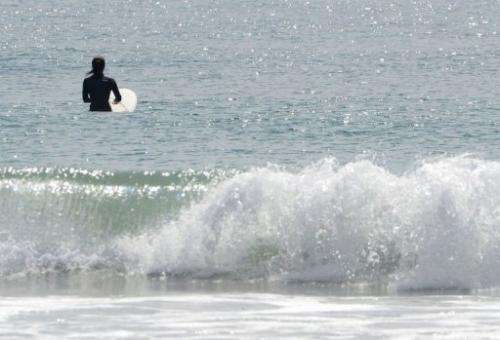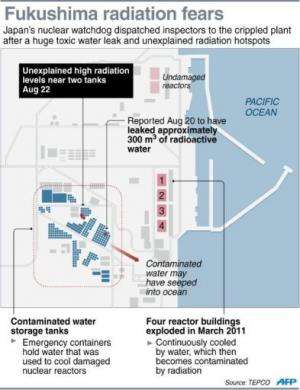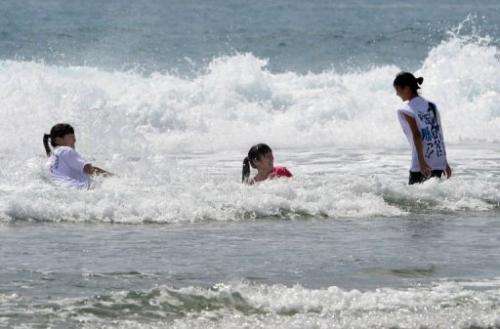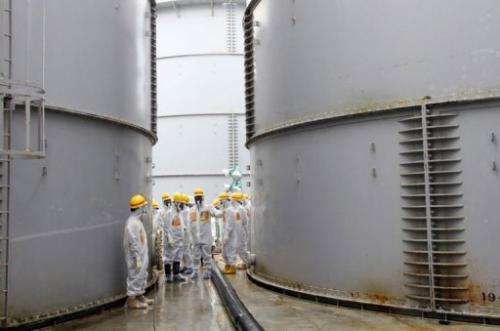Sun, sand, surf and radiation in shadow of Fukushima

With its towering waves, golden sand and stunning scenery, Toyoma beach in Iwaki is an almost perfect spot for surfing—if only it wasn't just down the coast from Japan's leaking Fukushima nuclear power plant.
"Of course we may seem a little crazy, but for us, the important thing is the waves," Yuichiro Kobayashi told AFP as he and around 30 other surfers dashed in and out of the water.
Just days earlier, Fukushima operator Tokyo Electric Power (TEPCO) announced sheepishly that one of the huge tanks storing highly radioactive water at the plant, some 50 kilometres (30 miles) to the north, was holed.
Around 300 tonnes of toxic water had seeped out of the vast container—one of around 1,000 on the site—by the time anyone noticed. Some may have made its way through drainage ditches and into the Pacific Ocean.
TEPCO said pools of water near the holed tank were so toxic that anyone exposed to them would receive the same amount of radiation in an hour that a nuclear plant worker in Japan is allowed to receive in five years.
The huge—and growing—volume of water at the site is a headache for TEPCO, with critics saying the utility is incapable of dealing with the problem.
Tonnes of polluted water have also leaked into the earth beneath the plant, where it has mixed with groundwater that is flowing out to sea.

TEPCO estimates that hundreds of tonnes of this groundwater makes its way into the Pacific every single day, where its radioactive load is dispersed. The utility says this water is not so heavily polluted.
Kobayashi, who has surfed for 30 years and is a member of a coastal protection group, sends samples of sand and seawater to a local technical college.
According to national standards, the water is safe.
Measurements taken before the latest leak was announced showed one litre of seawater contained 6.22 becquerels of caesium—below the 10 becquerel per litre safety limit imposed by Japanese authorities.
"I'm worried, but not enough to stop surfing," said Naoto Sakai, 31, who comes to test himself against the waves at least three times a week.
"If I worried about what I eat and where I live, I think I would become too stressed. I just try not to think about it too much."
Toyoma was closed to surfers for a year after the nuclear accident, which was sparked by a powerful undersea earthquake and the tsunami it generated in March 2011.

The coastline still bears the scars of the monstrous wave. Weeds sprout in the exposed foundations of homes that were washed away.
A sign reminds swimmers to be respectful towards the dead from the area, some of the more-than 18,000 people who perished when the sea visited its fury.
The beach was opened again in March 2012 but no longer hosts the international competitions it once boasted.
The local surfers are fewer, too, and older; the high school students who used to come now stay away.

Toshihisa Mishina, 42, got back in the water again last year, but says there is no way he would let his 12-year-old child join him.
"I worry about the youngsters because if they are exposed to radiation now, it might affect them when they grow up," he said.
The reticence of some surfers has knock-on effects for local businesses, says Etsuo Suzuki, who reckons income at his surf shop in Iwaki has shrunk to around half of what it was before the disaster.
Yuichiro Kobayashi, 51, who also owns a store in the area says times are tougher, and admits that he keeps a careful eye on radiation readings.
But he's not about to give up his passion.
"The waves were not so great today," he says as he shrugs loose his silver hair.
"No problem. I'll come back tomorrow."
© 2013 AFP





















